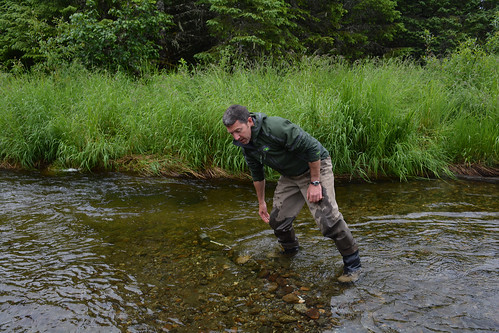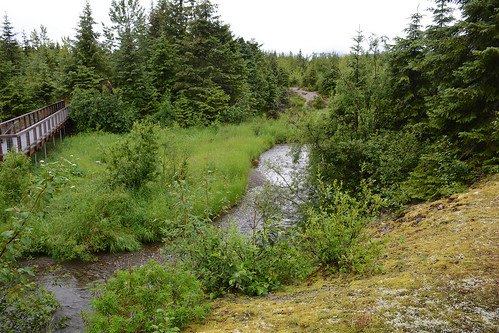
Since the second week in July, locals and visitors alike have congregated on the viewing platforms above Steep Creek near the Mendenhall Glacier Visitor Center in Juneau, Alaska to enjoy the sockeye salmon migration.
From mid-July through the end of August, the sockeye salmon enter the creek to dig redds (nests), find mates and spawn. For thousands of viewers this annual show is seen not in person but on the screens of their computers or smart phones, thanks to the Steep Creek salmon cam.
The first salmon cam installation at Steep Creek was a summer project for Eagle Scouts. With the unexpected popularity of the live video stream, fisheries biologist Pete Schneider and other employees of the Tongass National Forest have made significant improvements to the original setup. A closet in the center’s pavilion was used to house electrical equipment. New trenches were dug through the woods and coaxial cables were run through hard conduit so the camera could be hard wired and not have to depend on batteries. A new, high-resolution analog camera made for divers replaced the old camera. The camera was attached to rebar similar to a tent stake and pounded into the substrate of the creek bed in only 18 inches of water, although it can appear much deeper in the video.

For Schneider, the salmon cam is more than an opportunity to entertain the public. His desire is to call attention to the unique qualities of the fish habitat of Steep Creek.
“Steep Creek is a natural system with minimal impact from development,” Schneider said. “The importance of that cannot be overemphasized.”
He said that all stages of the salmon’s lifecycle can be observed at Steep Creek. Although the spawning ground is small compared to bigger systems in Alaska, at only two-thirds of a mile long, it produces a comparatively large number of fish. The lush vegetation along the stream banks is due to the constant return of the nutrients to the soil from the fish carcasses that are transported by bears and eagles.
“Sometimes people give value to the big systems like the Mendenhall River, the Taku River, or Montana Creek,” Schneider said. “The small systems can be undervalued and overlooked. But look at what Steep Creek produces.”
Although the amount of salmon currently spawning will wind down, numbers will increase again at the end of September.
“Once the sockeye run winds down in early September, the stream will be fairly quiet,” Schneider said. “Coho (silver) salmon will then enter towards the end of September, along with Dolly Varden.”

